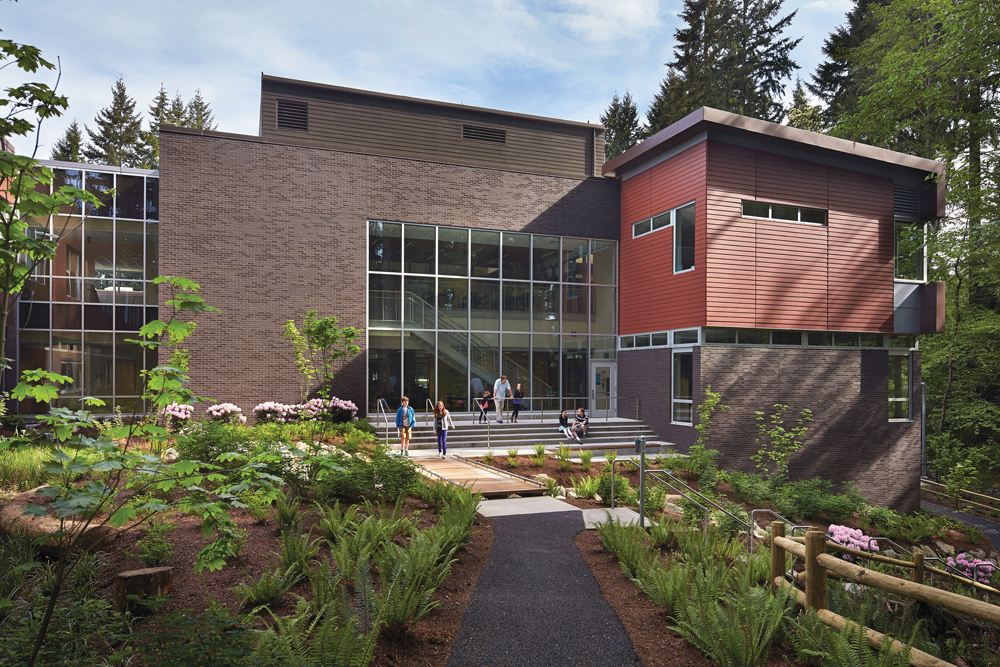Since last December 14, safety has become the paramount concern of every school official and school board member in this country. December 14, 2012, was the date on which 20-year-old Adam Lanza shot and killed 20 children and six adult staff members at Sandy Hook Elementary School, in Newtown, Conn. It was the second deadliest mass shooting by a single person in U.S. history, after the Virginia Tech tragedy of 2007.
Sandy Hook galvanized school officials, parents, public officials, and police departments, as they scrambled to figure out how to prevent a similar incident in their communities. Many asked: Could better design and construction of schools—preschool, elementary, and secondary—prevent or at least mitigate the casualty rate at another Sandy Hook? And could this be done not only for schools to be built in the future, where Building Teams would be working from a blank slate, but for the tens of thousands of extant schools from Maine to Hawaii, where physical conditions are often literally set in stone?
TOP K-12 SCHOOL SECTOR ARCHITECTURE FIRMS
2012 K-12 Revenue ($)1 DLR Group $38,250,0002 SHW Group $32,328,8433 PBK $31,760,0004 IBI Group $27,977,8605 HMC Architects $25,407,1646 Stantec $21,586,2097 Fanning/Howey Associates $20,247,0008 Perkins+Will $19,938,2119 Heery International $16,561,30310 LPA $14,438,017
TOP K-12 SCHOOL SECTOR ENGINEERING FIRMS
2012 K-12 Revenue ($)1 AECOM Technology Corp. $100,150,0002 URS Corp. $55,927,7783 STV $45,937,0004 Jacobs Engineering Group $36,550,0005 Parsons Brinckerhoff $19,100,0006 TTG $9,985,3007 Shive-Hattery $7,379,4258 BRPH $4,900,0009 KCI Technologies $4,200,00010 Dewberry $3,852,971
TOP K-12 SCHOOL SECTOR CONSTRUCTION FIRMS
2012 K-12 Revenue ($)1 Gilbane $947,077,0002 Balfour Beatty $483,944,4763 Turner Corporation, The $357,910,0004 CORE Construction Group $284,198,3755 Skanska USA $273,418,3516 McCarthy Holdings $260,000,0007 Kraus-Anderson Construction $211,000,0008 JE Dunn Construction $169,860,4369 Consigli Construction $148,883,46810 Barton Malow $139,236,049
These questions inspired a gathering of public officials, school designers and contractors, safety experts, and facility directors convened last February in Washington, D.C., by the Council of Educational Facilities Planners International. The daylong CEFPI Security Summit provided a framework in which to consider what school districts can do to provide a safer environment for children, teachers, and administrative staff. Following are the recommendations of immediate interest to the design and construction community.
Infrastructure needs beefing up, says CEFPI report
Emergency preparedness and response must be woven into the very fabric of school life, according to the CEFPI Security Summit report. The report recommends creating “concentric circles of protection” through the following means:
- Providing the ability to lock students behind doors to protect them from aggression (door hardware companies report that they cannot keep up with demand for lock systems since Sandy Hook)
- Shielding students from large windows
- Safeguarding children when they meet in large groups for meals and assemblies
- Installing high-security keying systems with control measures in place for master keys
- Securing children, teachers, and staff via secured vestibules and remote access to select exterior and interior doors (through keyless entry systems)
- Eliminating access to unauthorized persons by improving line-of-sight conditions and installing CCTV cameras
- Protecting entrances through the use of bollards and safeguarding the exterior and perimeter—including playgrounds, athletic fields, and parking lots—via upgraded lighting and camera monitoring
Mass notifiation high on school districts' agenda
The CEFPI report also recommends action on crisis communications, notably:
- Providing an effective public address system, with a backup power source
- Use of multiple communications devices, including mobile panic devices worn by key administrators
- Installation of security cameras and use of emergency radio channels
School districts are already acting. Plainfield District 202, the fourth-largest school district in Illinois, just ordered $180,000 worth of wireless alarm systems for its 30 schools.
As the fall term approaches, design and construction firms, as well as manufacturers of safety products and systems, will be called upon to safeguard the nation’s schoolchildren even more vigorously than in the past.
Read BD+C's full Giants 300 Report
Related Stories
Designers | Oct 1, 2024
Global entertainment design firm WATG acquires SOSH Architects
Entertainment design firm WATG has acquired SOSH Architects, an interior design and planning firm based in Atlantic City, N.J.
Higher Education | Sep 30, 2024
Studio Gang turns tobacco warehouse into the new home of the University of Kentucky’s College of Design
Studio Gang has completed the Gray Design Building, the new home of the University of Kentucky’s College of Design. In partnership with K. Norman Berry Associates Architects, Studio Gang has turned a former tobacco warehouse into a contemporary facility for interdisciplinary learning and collaboration.
Warehouses | Sep 27, 2024
California bill would limit where distribution centers can be built
A bill that passed the California legislature would limit where distribution centers can be located and impose other rules aimed at reducing air pollution and traffic. Assembly Bill 98 would tighten building standards for new warehouses and ban heavy diesel truck traffic next to sensitive sites including homes, schools, parks and nursing homes.
Laboratories | Sep 27, 2024
Traditional lab design doesn't address neurodiverse needs, study finds
A study conducted by ARC, HOK, and the University of the West of Scotland, has revealed that half (48.1%) of all survey respondents who work in laboratory settings identify as neurodivergent.
Laboratories | Sep 26, 2024
BSL conversions: A cost-efficient method to support high-containment research
Some institutions are creating flexible lab spaces that can operate at a BSL-2 and modulate up to a BSL-3 when the need arises. Here are key aspects to consider when accommodating a rapid modulation between BSL-2 and BSL-3 space.
MFPRO+ News | Sep 24, 2024
Major Massachusetts housing law aims to build or save 65,000 multifamily and single-family homes
Massachusetts Gov. Maura Healey recently signed far-reaching legislation to boost housing production and address the high cost of housing in the Bay State. The Affordable Homes Act aims to build or save 65,000 homes through $5.1 billion in spending and 49 policy initiatives.
Designers | Sep 20, 2024
The growing moral responsibility of designing for shade
Elliot Glassman, AIA, NCARB, LEED AP BD+C, CPHD, Building Performance Leader, CannonDesign, makes the argument for architects to consider better shade solutions through these four strategies.
Mixed-Use | Sep 19, 2024
A Toronto development will transform a 32-acre shopping center site into a mixed-use urban neighborhood
Toronto developers Mattamy Homes and QuadReal Property Group have launched The Clove, the first phase in the Cloverdale, a $6 billion multi-tower development. The project will transform Cloverdale Mall, a 32-acre shopping center in Toronto, into a mixed-use urban neighborhood.
Codes and Standards | Sep 19, 2024
Navigating the intricacies of code compliance and authorities having jurisdiction
The construction of a building entails navigating through a maze of regulations, permits, and codes. Architects are more than mere designers; we are stewards of safety and navigators of code compliance.
Higher Education | Sep 18, 2024
Modernizing dental schools: The intersection of design and education
Page's John Smith and Jennifer Amster share the how firm's approach to dental education facilities builds on the success of evidence-based design techniques pioneered in the healthcare built environment.

















